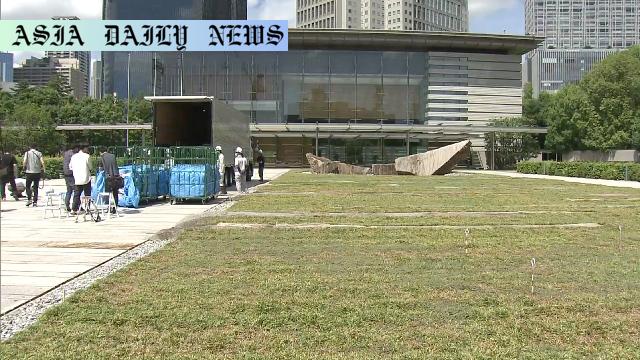Radioactive soil: First batch of low-level radioactive soil from Fukushima was reused in Tokyo, aiming to reduce final disposal waste.
- The first batch of radioactive soil from Fukushima was reused in Tokyo.
- The government seeks to minimize soil designated for final disposal.
- Standards ensure safe radiation levels within international norms.
- Public response and radiation levels will be monitored weekly.

Introduction: First Reuse of Radioactive Soil in Japan
The first example of low-level radioactive soil reuse from the Fukushima Daiichi nuclear disaster has marked a significant step forward in Japan’s efforts to recycle contaminated waste. On Saturday, soil from Fukushima arrived at the Prime Minister’s Office grounds in Tokyo for the first reuse project outside the prefecture affected by the 2011 accident. This initiative highlights Japan’s commitment to reduce the massive volume of contaminated soil awaiting disposal while addressing public concerns surrounding radiation safety.
Details of the Project and Safety Standards
A total of 14 million cubic meters of radioactive soil, removed during decontamination efforts in Fukushima Prefecture, is currently housed in interim storage facilities. By law, the government is mandated to ensure the final disposal of this soil outside the Fukushima region by 2045. In this first project, two cubic meters of soil with a radioactive cesium concentration of 6,400 becquerels per kilogram (within the government’s safety limit of 8,000 becquerels) will be buried at a depth of 60 centimeters and overlaid with 20 centimeters of regular soil.
The Environment Ministry has assured the public that these standards are in compliance with the international guideline of 1 millisievert per year as the maximum radiation dose for public exposure. To ensure transparency, weekly monitoring and reporting of radiation levels around the Prime Minister’s Office grounds will be carried out and published on official channels.
Challenges and Impact on Public Perception
This reuse project represents a breakthrough in public acceptance of strategies to reduce and manage radioactive waste. Previous attempts to incorporate contaminated soil into projects were limited to demonstrative efforts within Fukushima Prefecture itself. However, skepticism remains among residents of Tokyo and other areas over the long-term safety and environmental impact of reusing lightly contaminated materials for public works projects.
The government’s effort to educate the public about the safety measures in place is seen as critical to gaining widespread acceptance. If successful, this approach could serve as a model for other regions globally that are grappling with the disposal of low-level radioactive materials.
Implications for Waste Management and Sustainability
Beyond addressing immediate waste management concerns, this initiative aligns with the global trend towards sustainable practices. Reducing the volume of waste requiring long-term storage or disposal helps alleviate the strain on limited disposal facilities. It also showcases Japan’s efforts to innovate eco-friendly methods to deal with nuclear byproducts responsibly.
Given the complex legacy of the 2011 Fukushima disaster, the reuse program is not only a technical challenge but also a symbolic gesture of resilience and progress. Yet, it raises questions about achieving similar levels of safety in large-scale projects, where the concentration and volume of radioactive materials may vary significantly.
Conclusion
The reuse of low-level radioactive soil in Tokyo marks a significant milestone in Japan’s efforts to manage the fallout of the Fukushima Daiichi nuclear accident. While challenges related to public trust, environmental safety, and scalability remain, this initiative underscores the importance of innovation and transparency in addressing complex environmental issues. The world will closely observe this project as Japan continues to balance risks and benefits, setting a potential precedent for similar challenges globally.



Commentary
The Importance of Public Trust in Nuclear Waste Management
The reuse of low-level radioactive soil in Tokyo is a bold and necessary step for Japan, a nation grappling with the lingering effects of the 2011 Fukushima Daiichi disaster. This initiative demonstrates the government’s commitment to addressing the long-term challenges of radioactive waste management through innovation and transparency. However, such projects are only as successful as the public’s trust in the safety measures behind them.
Balancing Technical Achievements and Public Concerns
While government officials assure the public of rigorous safety standards and regular surveillance, many residents remain skeptical of the initiative. Public reactions to radioactive waste are often influenced not just by data, but by deep-seated fears and historical mistrust related to nuclear energy. To bridge this gap, the Japanese government must prioritize open communication, education, and active engagement with communities across the nation.
Global Implications for Waste Management Policies
Japan’s decision to reuse radioactive soil within strict safety guidelines could inspire other countries facing similar waste disposal issues. This initiative underscores the importance of finding innovative solutions that both mitigate environmental risks and align with international safety protocols. However, it also raises questions about the long-term sustainability of relying on public works projects as a primary method for waste disposal.
A Step Forward Despite Lingering Challenges
Ultimately, this project is a step in the right direction, but it is clear that the road ahead will require meticulous planning and steadfast public engagement. The success of this reuse initiative will depend not only on technical execution but also on fostering a shared sense of responsibility and trust among stakeholders. As the world watches Japan’s efforts unfold, it is evident that balancing innovation, safety, and public perception is the key to sustainable waste management in the nuclear age.